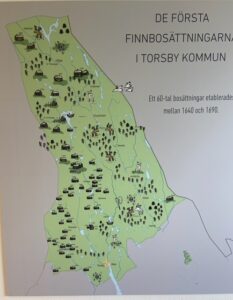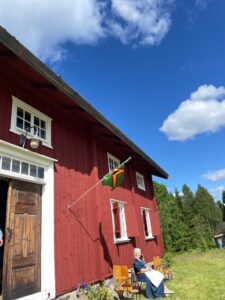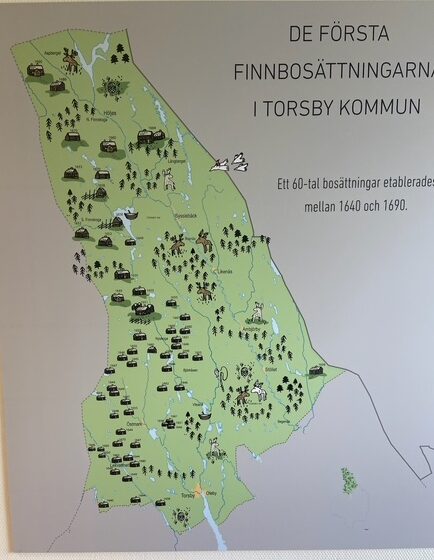
The day after Mia and I arrived in Finn Forest, we drove to the Torsby Finnskogsentrum – a place dedicated to Finn Forest artifacts and history just a short drive outside the town of Torsby. The map to the right comes from that center: “The First Finnish Settlements in Torsby Area.” Sixty of them! How would we ever find those those where our ancestors had lived?
After immersing ourselves in farms and lives, we asked for a referral to a nearby place to eat. Sebastian, who was working the counter, was mentioning shops when we noticed delicacies right there. Yes, they had a few things, but very few, he replied. Open-faced sandwiches . . . delectable!
While we ate, Sebastian gave us hints for exploring the forest. Monica Björklund, the center’s director, slipped into a side room. She came back with a packet of topographical maps and lists of farms with their inhabitants. On the lists she had highlighted our ancestors’ names. Farm names were circled on the maps. Months before, Monica had asked for the names and places I knew of. I had given her a few; she had searched the archives and found tracks of ancestral lives.
We went home to Karhula (our cabin, “place of the bear”), and I looked through the pile. Where were these places? Which direction was north? Who was the parent of whom?
We went to sleep. The next day was Midsummer Eve – the day of the May Pole and the star made of trees. And after that was Forest Finn Day in Sweden. On that day, people who love the forest and descendants of those who lived in it and people committed to keeping the forest and its heritage alive gather to celebrate.
We’d been encouraged to go to Purala, a farm near the Norwegian border. There a traditional Forest Finn meal would be served on an authentic Forest Finn farm. We showed up at the advertised time – with Finnish matti to sample for the first time, who wouldn’t?
Two women were waiting by the door of the red-stained wooden house with its four shutter-sided windows on the first floor and its five four-paneled windows on the second. “We’re not leaving until they start serving food,” these hungry Finns told us, “but, as usual, the meal will be late.” We looked in through the wooden doors toward the bustle in the kitchen inside. It would be a while.
We left to visit places nearby, planning to come back to this cedar-roofed house with hearty appetites.
When we returned, food was being served and we were hungry. Folks were stepping out onto the stone doorstep with full plates. We walked to the bench by the door to pay.
Until this moment we had successfully paid for everything with credit cards. Here there was no card reader. A sign said we could pay with Vips, something like PayPal. Mia tried to download Vips, but we had no signal or internet access. We could pay with cash, but we had, as yet, no Swedish money.
The smell of pork and matti-porridge wafted from the house. I asked a new set of women by the door where the nearest minibank was. “In Torsby” the more talkative woman said. Torsby was half an hour away by car. When we got back in an hour, would any food remain?
Still, we walked toward the car. Hungry and a bit low, I asked, “Mia, do you have any cash, any kind of cash?” “Twenty dollars,” was the reply.
I took the money and walked back to the woman by the door. “Excuse me, but might you ever have a need for an American 20? Could you possibly exchange this for Swedish money so we could buy food?”
She opened her bag, took the twenty, and gave me a chunk of Swedish cash. We walked into the house and, from near the huge smokestove in the corner, got our own plates of matti and bacon and lingonberry jam. You may not think that coarse oatmeal porridge drizzled with jam and bacon fat would be good, but then, you probably haven’t eaten such a feast made by white-aproned forest elders. We loved it.
Counting our change, we found enough for dessert. When we entered the house, the cook came from the kitchen and said, “Not those. Have strawberry-layer cake!” To be exact, she said it in Swedish, then went to the fridge and pulled out the creamy cake.
Delicious! We sat by the women at the door to eat our cake and thank them. Berit, who had given us the money, asked why we were in Finn Forest. Failing to answer coherently, I fetched from the car the maps and lists Monica had given me in Torsby. We bent our heads over them.
Berit noticed the name Pålstorp on the maps and said to the woman next to her, “Petra, you have to invite them to your farm.” Petra looked surprised but said, “Okay.”
I had already begged for food money; I was ready to take a somewhat coerced invitation to visit a farm where some of our family had lived.
Petra and I exchanged contact information. “Tomorrow,” she said, “would be fine. I’ll be home.”
We stayed for the concert on the grass as the shadows over the fields lengthened, and then we went home.
At the table, I opened that packet of maps again.
Monica had circled Pålstorp – Paul’s settlement. I looked at the census lists. Pålstorp wasn’t just any family farm. It was where my great-grandma Lisa had grown up. It was right next to the farm where her father had died, leaving behind eight children with Lisa, at 16, the eldest. His death was the impetus, I suspect, for the remaining family’s emigration to Minnesota.
Pålstorp . . . the most important place for our ancestral search.
And we would be going there the very next day.

A cook resting after preparing a feast at Purala
(photo by Amelia Hanson)

Wow! Great story – amazing how those connections happen, as though guided by invisible forces/ancestors seeking the reunion just as you are! Thanks for sharing!
Thank you for sharing! What an exciting journey!
Delightful!